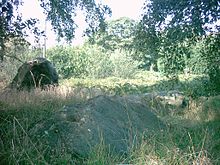Addington Long Barrow

View of the damaged burial chamber
|
|
| Location | Addington, Kent |
|---|---|
| Type | Long barrow |
Addington Long Barrow is a chambered long barrow located near to the village of Addington in the southeastern English county of Kent. Constructed during Britain's Early Neolithic period, today it survives only in a ruined state. Built out of earth and around fifty local sarsen megaliths, the long barrow consisted of a sub-rectangular earthen tumulus enclosed by kerb-stones. Collapsed stones on the northeastern end of the chamber probably represented a stone chamber in which human remains might have been deposited; none, however, have been discovered.
Archaeologists have established that the monument was built by pastoralist communities shortly after the introduction of agriculture to Britain from continental Europe. Although representing part of an architectural tradition of long barrow building that was widespread across Neolithic Europe, Addington Long Barrow belongs to a localised regional variant of barrows produced in the vicinity of the River Medway, now known as the Medway Megaliths. Of these, it lies near to both Chestnuts Long Barrow and Coldrum Long Barrow on the western side of the river. Three further surviving long barrows, Kit's Coty House, the Little Kit's Coty House, and the Coffin Stone, are located on the Medway's eastern side.
After the Early Neolithic, the long barrow fell into a state of ruined dilapidation, with a small road being built through the centre of the monument by the 19th century at the latest. Local folklore grew up around the site, associating it with the countless stones motif. The ruin attracted the interest of antiquarians in the early 18th century, and was studied by local archaeologists in the 20th. Both it and the nearby Chestnuts Long Barrow are open for public viewing by appointment with the landowner.
...
Wikipedia

